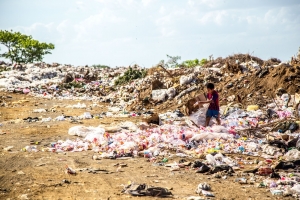Environment and children
3 Ways in which Climate Uncertainty is Impacting Children
Michel d. S. Mesquita, PhD
I have been part of a number of climate studies, meetings and conferences. While discussions often have focused on modeling (my field), policy, water cycle, energy, among others- very little has been about the effect climate change could have on children. But with the recent release of the Fourth National Climate Assessment, it is appropriate to consider the impact climate uncertainty has on our most vulnerable members of society.

Source: Photo by Caleb Woods on Unsplash
1. Children are one of the most vulnerable groups exposed to new disease
The Zika virus epidemic in Brazil is a recent example on how vector borne diseases have affected children already now. It’s reported that about 4,000 babies were born with microcephaly due to the Zika virus (1). This is a condition in which a baby head is small compared to their body size, with consequences to their proper neurodevelopment.

Source: Photo by Hermes Rivera on Unsplash
The Zika virus is transmitted through the Aedes mosquito. These mosquitoes thrive in warm temperatures and water puddles left unchecked. Open sewage, as a result of improper infrastructure, is also a field for the proliferation of even more mosquitoes. Since its discovery, Zika-carrying mosquitos have migrated as far north as the Southern US, impacting communities across South, Central, and North America. In an uncertain future climate, Zika could become a major epidemic, affecting even more children.
2. Children’s life-long health is a direct result of the quality of their air
Air pollution is another threat to children’s well being. A quick Wikipedia search under the topic “street children” shows that about 100 million children grow up in the streets. Many live in large urban areas of densely populated and air polluted cities.

Source: Photo by Viktor Juric on Unsplash
When these children are exposed to smog, PM2.5 particles, which stands for particulate matter of the size of 2.5 micrometers, deposits in their lungs. They may impair the lung function, since they can penetrate deeply into the alveolar wall and bloodstream. Life-long health issues develop as a result of excessive PM2.5 exposure. For street children, health care is not an option, which is why their survival rate is not high (2). Since meteorological conditions may affect the concentration of PM2.5 in the atmosphere, a combination of future changes in weather conditions and policies concerning pollution may influence considerably the future of street children. As a result, air quality poses a threat to children’s survival.
3. Children face high levels of stress at young ages
As environmental threats become more common and their impacts less certain, stress becomes an ever-persistent emotion, for adults as well as children. The recent California fires and the devastation of Paradise, a town located about 3 hours from San Francisco, showcases how stressful it can be for families. Many have lost their homes, others have lost their loved ones, or both. For children having to evacuate or miss their home, pets, family members, it must be devastating. Such stressful conditions could potentially affect their future development. This is just one example of an serious of natural disasters in recent years, which has put families in difficult positions physically and financially
Uncertainty in climatic conditions is already affecting children. More studies are needed to understand what the future could bring to these small ones. By then, many will have become adults and will already be seeing their own children being affected as well.
1 The Guardian (2018), URL: https://www.theguardian.com/world/2018/jul/20/zika-epidemic-sheds-light-on-brazils-invisible-children
2 *What About America’s Homeless Children?: Hide and Seek: https://tinyurl.com/ybfxezfz
*not many studies are available on mortality, a study mentions that it can be 10 times higher compared to a regular person at the same age group.

